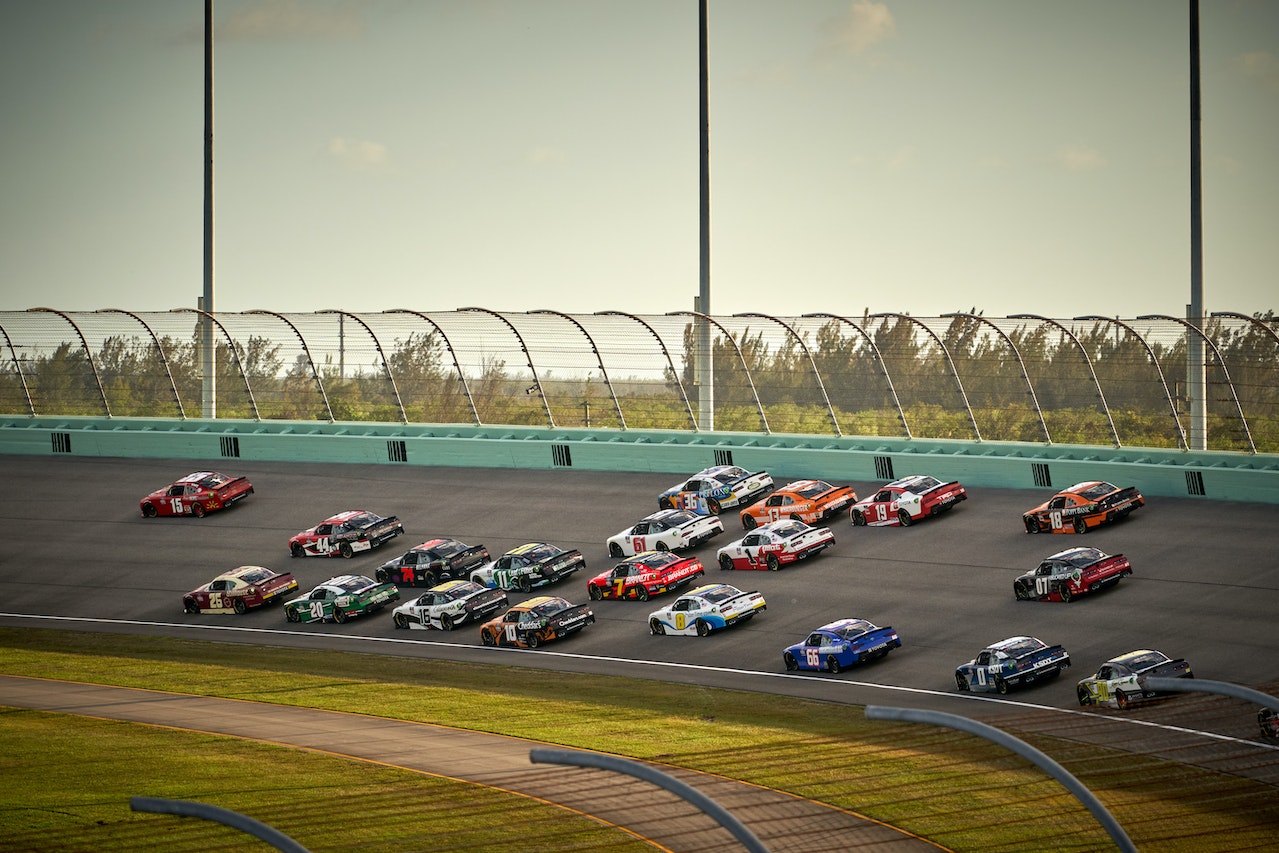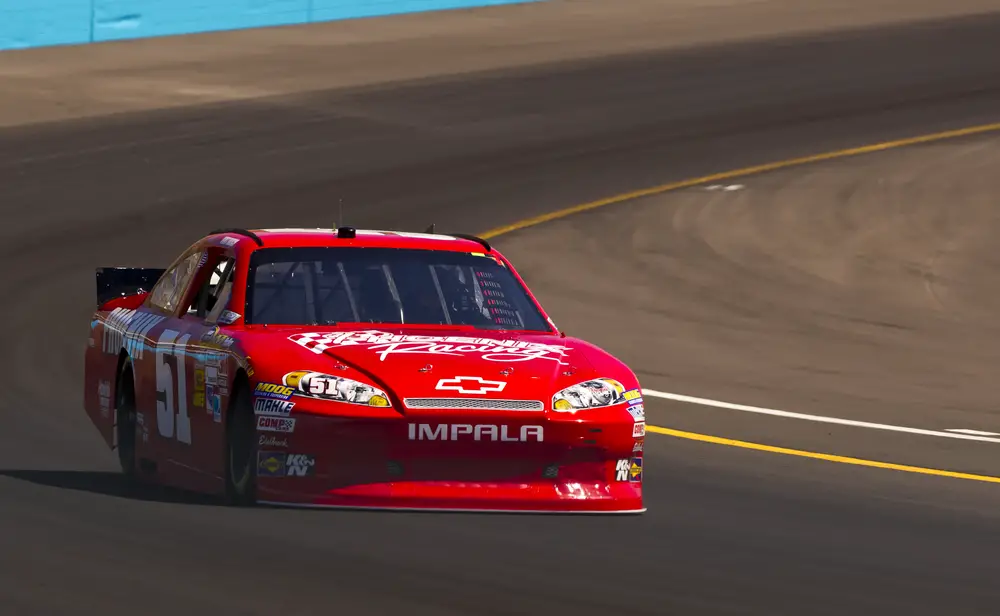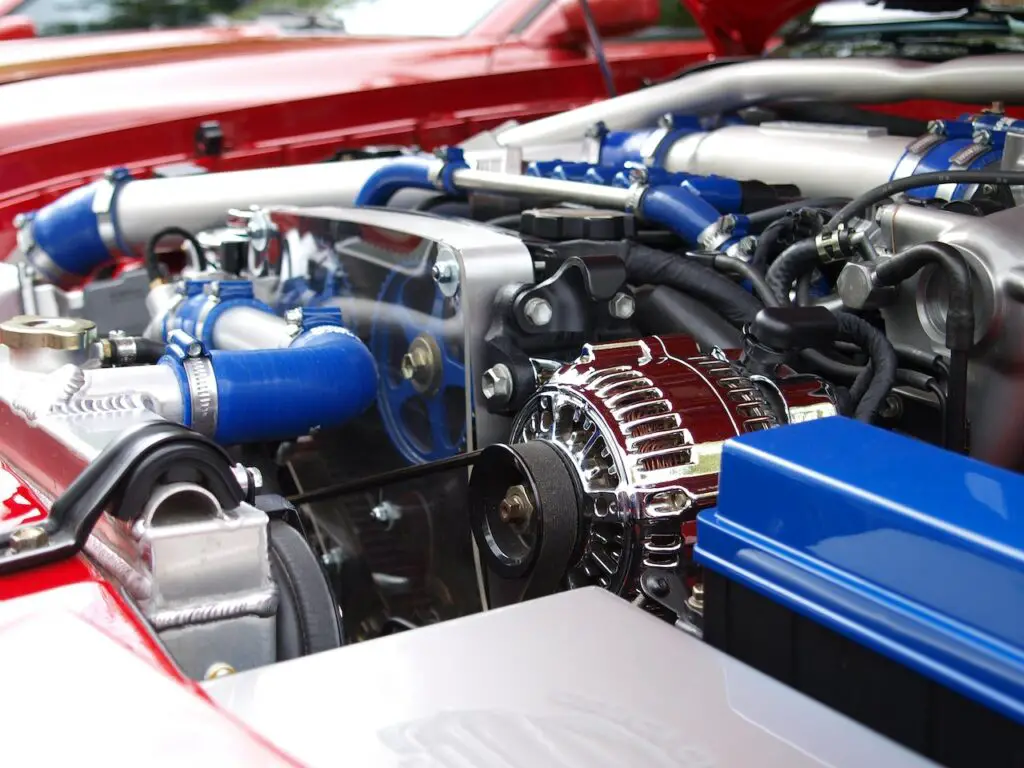As they whiz around the track, blazing by spectators at breakneck speeds, NASCAR cars look pretty much the same. Aside from paint color and decals, NASCAR cars look about the same, especially to an untrained eye.
Key Points
- NASCAR cars have a similar shape due to aerodynamic efficiency and rules mandated by NASCAR.
- Components such as tires, wheels, suspension, fuel systems, and electronics are identical across all cars.
- Exterior aesthetics and body shells allow teams to innovate design within the confines of NASCAR’s set of 30 templates.
They’re about the same shape, sit low to the ground, and seemingly whiz around the track at similar speeds. So, why do all NASCAR cars look the same? Are there any differences? Let’s find out!
Are NASCAR Cars The Same?
Although NASCAR rigs might look the same as they thunder past, they’re not all the same. They share a few crucial similarities, including the tires, wheels, suspension, fuel, fuel systems, electronics, and transmissions, which are identical.
Aside from these factors, each team can use a few distinguishing features to differentiate itself from the rest. NASCAR outlines stringent specs for each car, so teams must work within their guidelines, but the engines and body shells give teams an opportunity to diversify their cars.
Are All NASCAR Cars Shaped The Same?
As you watch a NASCAR race, either from the comfort of your couch or the excitement of the stands, you might question the cars in the race. Why do they all have a similar shape? The reasoning behind this falls to aerodynamics and NASCAR rules.
Aerodynamics
The shape of NASCAR race cars is optimized for optimal aerodynamic efficiency. If the cars were designed like regular cars, they would be working against more air resistance, and even these seemingly little things count when racing. So, to ensure the cars race with the least amount of air resistance possible, they feature a similar shape.
Teams will switch out their aerodynamic setups, also called “packages,” to reflect which track they’re working on. They’ll adjust various components, swapping out spoilers and front splitters, as they want the car to handle optimally based on the track. In addition, they often make adjustments to the aerodynamic panels tucked underneath the car.
NASCAR Rules
Aside from the aerodynamics, NASCAR cars boast similar shapes due to rules. NASCAR’s rules include a set of 30 templates, each featuring a focus on different contours of the car. For example, consider the top of the car, from front to back. The biggest template of the bunch fits over this centerpiece, extending from front to back.
With the template laid across the car, the gaps between it and the car must be no greater than an exact tolerance. Every template features marks on its edge with colored lines. Red lines indicate the gap must be less than 0.07 inches, blue lines indicate the gap needs to be less than 0.25 inches, and green lines translate to less than 0.5-inch gaps.
Although these templates allow a bit of leeway with designs, the general shape of the cars tends to remain the same. There are certain areas that the 30 templates don’t cover, so these spots aren’t strictly covered by NASCAR and allow a little bit of wiggle room.
When making the cars, they use the chassis, made up of the template, complete with steel tube welding to form the car’s skeleton. Each team attaches its own body fiberglass shell to the chassis, integrating manufacturer-specific front splitters, rear fascias, and side skirts. These parts of the car create a unique look for each car while simultaneously maintaining a look of unity.
The basic shell of the car, tires, and suspension are nearly identical from one car to the next, but the exterior shell gives teams the opportunity to create a bit of visual diversity with their vehicles.
Application
Not every NASCAR car is built to meet the same specifications, as some are designed for specific purposes. For example, some cars are designed for short-track races, while others are designed for superspeedways.
There are a few key differences between the two, and while the shape might not change drastically, the design variance is essential.
NASCAR Standards And Regulations
While the exterior of the car features a unified appearance with distinctive aspects, NASCAR outlines strict rules and regulations for various parts of the car. Among the list of regulated parts, you’ll find:
- Engine block
- Cylinder heads
- Intake manifold and spacers
- Crankshaft
- Camshaft
- Valve train
- Pistons
- Connecting rods
- Bearings
- Harmonic balancer
- Fuel pump
- Fuel injectors
- Ignition systems and coils
Racing teams must abide by regulations surrounding these parts or risk disqualification, fines, or docked points. Each car must pass an inspection to avoid these results. However, they can reuse parts, and there is a bit of leeway surrounding certain elements. Take the block and cylinder heads of the engine, for example. These parts can be re-machined but still must fall within specific tolerances.
Given the strictly regulated aspects of the car, nearly every engine under the hood in a NASCAR car has the same performance. Teams cannot use any turbocharged engines, as they’re prohibited and have never been used in the history of the sport.
Do NASCAR Cars Produce The Same Horsepower?
As mentioned, nearly all NASCAR cars have the same performance, as rules surrounding various aspects of the car create an even playing field. The current engines NASCAR cars use can handle between 900 and 1,000 hp without an issue.
However, due to rules, cars are restricted to a maximum of 750 hp on oval tracks shorter than one mile. On tracks longer than one mile, the maximum horsepower is further restricted to 550. The reasoning behind the restrictions falls to safety and allows greater overtaking.
In order to restrict the horsepower capabilities of these engines, the engine features tapered spacers. The spacers serve as air restrictors, featuring conical holes in sturdy steel plates. The cone-shaped holes regulate airflow into the intake and combustion chamber, effectively cutting the power the engine can generate.
Conversely, NASCAR can also use RPM restrictions. With this method, NASCAR restricts the RPM to 9,000 for every engine type, effectively reducing the engine’s horsepower. According to NASCAR rules, manufacturers and teams must stick to a specific size of the engine’s bore and stroke set to a set number. By implementing this, the engine is restricted, only able to generate a certain amount of RPM and compression it uses to turn over.
These restrictions create a level playing field, as each engine is reduced to the same output.
Who Makes NASCAR Cars?
Although NASCAR cars are drastically different from the everyday drivers you see on the road, they’re made by some of the same manufacturers. Ford, Toyota, and Chevrolet hold their places as the three current manufacturers contributing to the NASCAR lineup.
Each manufacturer must abide by the same rules, submitting its engine design to NASCAR approval. As of 2022, every NASCAR race car is known as a Next-Gen car or Gen-7 car, a template that was introduced to make stock cars better mimic the looks of street-legal cars.




